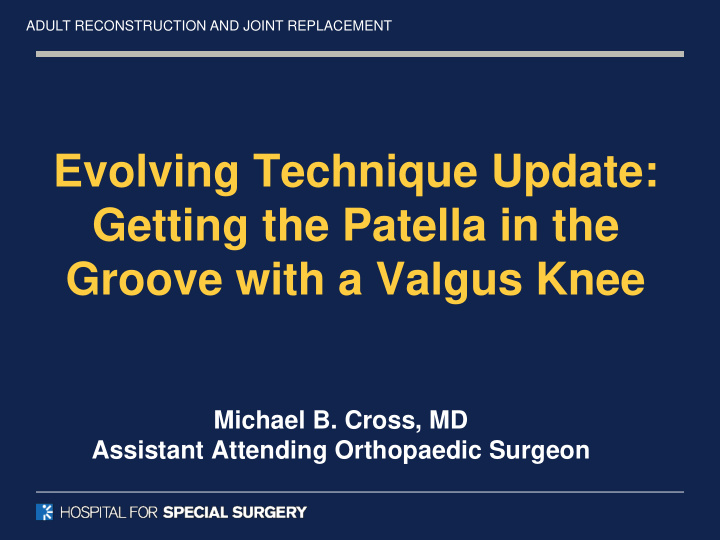



ADULT RECONSTRUCTION AND JOINT REPLACEMENT Evolving Technique Update: Getting the Patella in the Groove with a Valgus Knee Michael B. Cross, MD Assistant Attending Orthopaedic Surgeon
Disclosures • Consultant: • Smith & Nephew • Link Orthopaedics • Exactech Inc. • Intellijoint • Acelity • Theravance Biopharma • Zimmer Biomet • Honorarium • Acelity • Editorial Board • Techniques in Orthopaedics • Bone and Joint Journal 360 • Journal of Orthopaedics and Traumatology ADULT RECONSTRUCTION AND JOINT REPLACEMENT
The Valgus Knee • The valgus knee deformity is a challenge in TKA • Operation is harder when valgus angle ≥ 10 ° and not correctable • Observed in nearly 10% of patients undergoing TKA ADULT RECONSTRUCTION AND JOINT REPLACEMENT 3
Anatomic Contributions to the Valgus Knee Soft Tissues Tightening of the lateral structures: Bone Loss – Lateral collateral ligament – Lateral cartilage – Lateral PFL erosion Combined – Posterolateral capsule – Lateral condylar hypoplasia – Popliteus tendon – Metaphyseal femoral – Hamstring tendons and tibial plateau remodeling – Lateral head of the gastrocnemius – IT band ADULT RECONSTRUCTION AND JOINT REPLACEMENT 4
Common Patellar Complications Post op • Patellar stress FX • Patellar instability • Extensor mechanism disruptions • Patellar maltracking • Component wear • Patellar component loosening • Patellar component disassociation How do we prevent patellar complications, particularly maltracking? ADULT RECONSTRUCTION AND JOINT REPLACEMENT 5
My Surgical Technique: The Medial Parapatellar Approach • Not difficult to address lateral side • Becomes extensile by extending further proximal onto quad tendon • Limit medial dissection – BUT… Still release of posteromedial structures to dislocate the knee ADULT RECONSTRUCTION AND JOINT REPLACEMENT 6
PREVENTION - Surgical Considerations • Beware of internal rotation and medialization of femoral component – Shifts the trochlear groove medially – Increase lateral retinacular strain • Do not rely on the posterior condyles of L M femoral component rotation! – Posterolateral condylar deficiency !!! Bolognesi Files ADULT RECONSTRUCTION AND JOINT REPLACEMENT 7
PREVENTION - Surgical Considerations • Beware of internal rotation and medialization of tibial component – Causes tibia to externally rotate in flexion – Increases Q-angle ADULT RECONSTRUCTION AND JOINT REPLACEMENT 8
PREVENTION - Surgical Considerations • Pay attention to the anterior compartment! • Avoid overstuffing the patellofemoral joint by: – Anteriorization of the femoral component – Thick patellar component – Oversized femoral component Victor J. Which implant do I pick? A glossary of promises, Orlando, FL: 2008. ADULT RECONSTRUCTION AND JOINT REPLACEMENT 9
PREVENTION - Patellar Positioning • Resection that preserves at least 12-15mm remaining patella thickness to anchor prosthesis • Goal of positioning is to improve tracking & decrease wear – Place medially and superiorly – Anatomic positioning of central dome (over medial sagittal ridge) • Inside out lateral release of lateral tissue off patella – Remove the lateral facet ADULT RECONSTRUCTION AND JOINT REPLACEMENT
Patellar Tracking as a Final Check • Good indicator of appropriate component positioning • Good positioning reduces need for lateral retinacular release to less than 5-10% • Should track smoothly and contact femoral component throughout ROM •Always consider the effect of the tourniquet ADULT RECONSTRUCTION AND JOINT REPLACEMENT
”Ok, I’ve done all that… Now what?” ADULT RECONSTRUCTION AND JOINT REPLACEMENT
My steps to addressing the problem • Take down the tourniquet first! • When checking tracking make sure you are not externally rotating the foot • Slight lift off – clamp the arthrotomy together and test again • No improvement – Release lateral PFL • No improvement – Place two Kochers along medial arthrotomy and have my assistant pull medially – Release tight lateral retinaculum leaving capsule intact – I only do a full lateral release if nothing else works. ADULT RECONSTRUCTION AND JOINT REPLACEMENT
Summary • Technique for patellar alignment in the valgus knee must take into consideration BOTH soft tissue and bone loss • PREVENTION IS KEY to avoiding patellar problems – Avoid IR of the femoral or tibial components – Avoid medialization of the femoral or tibial components – Place the Patella Medial and Superior in its anatomic position – Avoid overstuffing the patellofemoral joint • Always check for smooth and continuous patellar tracking BEFORE AND AFTER tourniquet deflation – DO NOT PERFORM A LATERAL RELEASE UNTIL TOURNIQUET IS DOWN ADULT RECONSTRUCTION AND JOINT REPLACEMENT
Summary Peel tissue off lateral facet and remove lateral facet Release Lateral PFL Release Lateral Retinaculum, preserving the capsule Full lateral release ADULT RECONSTRUCTION AND JOINT REPLACEMENT
ADULT RECONSTRUCTION AND JOINT REPLACEMENT THANK YOU
Recommend
More recommend